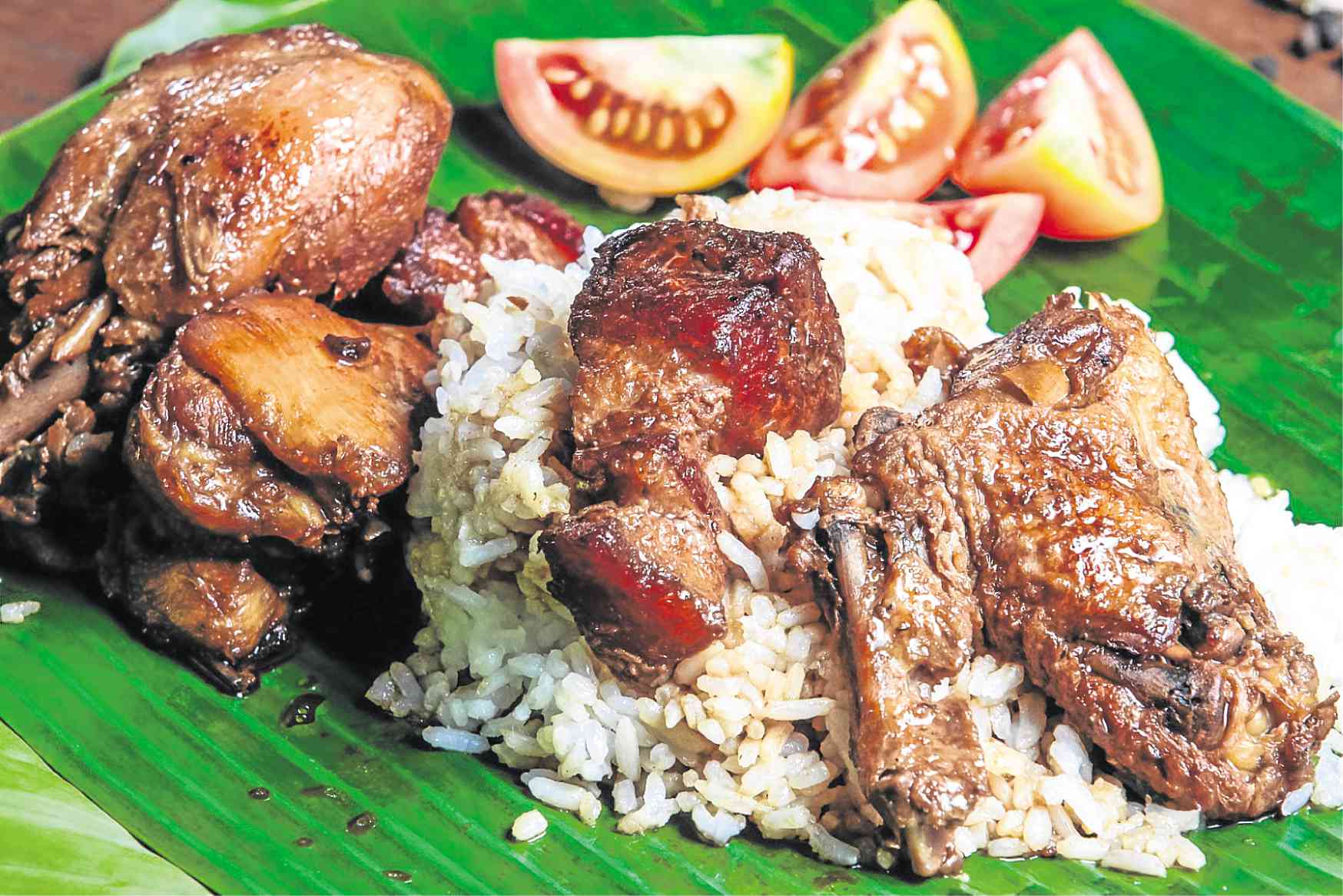
Anton Lorenzo prefers serving his Chicken Pork Adobo the traditional, rustic way —the binalot or wrapped style.
He puts the meat on a mound of steamed rice, with quartered tomatoes and hard-boiled eggs on the side, and wraps everything in banana leaves. The leaves add aromatic flavor to the simple dish.
“It’s also very easy to clean up,” says Lorenzo, who runs the family business La Huerta Estate, a popular events place in Antipolo City. “We eat it with our bare hands. We have a lot of banana leaves around the house.”
Lorenzo grew up in the family’s ancestral house in Antipolo. Built in 1969, the 1.5 hectare property was a venue for relatives and friends to get together and eat. It had lots of fruit-bearing trees, ornamental plants and vegetables.
This was where Lorenzo learned to prepare adobo, one of the family’s favorite dishes.
He recalls: “This heirloom recipe was passed on by my lola (Luisa Buhay) to my mom (Luz Lorenzo), who in turn taught it to our family cook Manang Ann.”
It’s the saucy kind of adobo, with a combination of chicken and pork meat. The family enjoys this adobo swimming in fatty oil.
Organic recipe
“My kids pour the sauce on their rice until it turns brown,” Lorenzo says. “Even their friends enjoy the adobo.”
Instead of liempo (pork belly), Lorenzo prefers using kasim (shoulder) because of its fat and tissue that make it ideal for slow cooking.
For chicken, he goes for the thigh and drumstick. “I prefer the dark meat,” he says.
He combines a kilo of chicken and pork in a deep pot, covers them completely with white vinegar before tossing in the garlic, peppercorn, bayleaf and soy sauce. The mixture is left to boil until the meat gets tender.
“I once tried using Ilocos vinegar in my adobo. I like its tanginess and intense flavor, but my kids and their friends don’t like it. They are my target market. That is basically why I cook,” says Lorenzo, a single dad to Carlos, 21, Teresa, 18, and Manuel, 16.
He separates the meat from the sauce, fries and toasts them. Once the meat is nice and brown, he puts them back in the sauce and lets everything simmer for a little while. He doesn’t add water because he feels it dilutes the overall taste and essence of the adobo.
“It’s a very pure, organic recipe—not sophisticated at all,” Lorenzo says. “But it packs a lot of flavor and brings back good memories to our family.”
He pairs the adobo with slices of tomatoes seasoned with patis (fish sauce) and pepper. His mom enjoys it with ripe mangoes and bananas.
“This is the same adobo recipe we ate whenever we had family picnics in Antipolo for 40 or more guests,” he says. “We still wrap them in banana leaves for gustatory impact.”

Late bloomer
Lorenzo—who now lives with his children in Makati, but regularly hies off to Antipolo whenever his family has guests or clients—admits enjoying cooking late in life.
“I just ate when I was younger,” he recounts. “In fact, my first venture in baking was a disaster. I forgot to put baking powder.”
Yet he grew up around food, absorbing and seeing all the preparations and cooking from his mom, aunts and Manang Ann. He would hang around with his siblings and cousins in the kitchen and watch the cooking.
He never thought about cooking on his own, because “almost everybody in our house cooked. I didn’t have to.”
Lorenzo started cooking out of necessity—there was no household help.
The adobo has become a weekly staple in his house. When there’s leftover, becomes crispy adobo flakes.
He has also learned from watching cooking shows on TV and YouTube.
“We also have a lot of recipe books at home,” he says, “but YouTube has made it easier for me. That’s how I learn to cook most.”
Aside from adobo, his children crave his Beef Pares, Beef Ribs Stew, Lechon Kawali, Sinigang and Hofan noodles.
His love for steaks has likewise driven him to look for the best way to cook it. “It starts with the quality and cut of meat,” says Lorenzo, who prefers rib-eye steak that he seasons with salt and pepper, thyme, garlic and butter.
When he’s in Makati, he pan-sears the meat in a cast iron pan. When he’s in Antipolo, he cooks over an open flame.
His greatest satisfaction in cooking? “When my children eat, smile and then say, hmmm. That’s what drives me crazy about cooking.”
Manang Ann’s Chicken Pork Adobo
1 l pork kasim
8 pc chicken thighs or drumsticks
2 c white vinegar
¾ c soy sauce
5 cloves smashed garlic
whole peppercorns
Ground black pepper to taste
3 laurel leaves
In a heavy pot, place the pork and chicken, add vinegar and soy sauce, garlic, pepper laurel leaves. Cook pork and chicken until tender (note that chicken cooks faster than pork).
Remove meat from pot and set aside the liquid. In a separate pan, fry the pork and chicken until nicely toasted. Return the meat into the pot and simmer for 30 to 45 minutes. Serve with rice.
Presentation suggestion: Put rice on a banana leaf, top with adobo and quartered tomatoes.












































